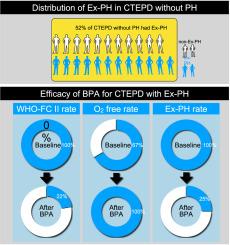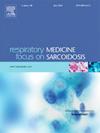Efficacy of balloon pulmonary angioplasty in patients with chronic thromboembolic pulmonary disease and exercise pulmonary hypertension
IF 3.5
3区 医学
Q2 CARDIAC & CARDIOVASCULAR SYSTEMS
引用次数: 0
Abstract
Background
The efficacy of balloon pulmonary angioplasty (BPA) in patients with chronic thromboembolic disease (CTEPD) without pulmonary hypertension (PH) remains unknown. Exercise PH (Ex-PH) is associated with impaired exercise capacity, even when pulmonary hemodynamics are normal at rest. We hypothesized that patients with Ex-PH could be the candidates for BPA. This study aimed to determine the prevalence and clinical profiles of Ex-PH and the effect of BPA on oxygenation and Ex-PH in patients with CTEPD and mean pulmonary arterial pressure (mPAP) ≤ 20 mmHg.
Methods
We retrospectively reviewed 23 patients (median age 65 years) with CTEPD and mPAP ≤20 mmHg at rest who underwent cardiopulmonary exercise testing with right heart catheterization. Patients were divided into two groups: Ex-PH, defined by an mPAP/cardiac output (CO) slope (mPAP/CO slope) > 3.0, and non-Ex-PH.
Results
Overall, 12 and 11 patients were identified as Ex-PH and non-Ex-PH groups, respectively. There were no significant differences in clinical parameters, including hemodynamics at rest, and blood gas analysis between Ex-PH and non-Ex-PH groups. Among 9 patients with Ex-PH, BPA improved World Health Organization-functional class and PaO2 at rest and was associated with a decrease in the mPAP/CO slope. All 3 patients discontinued LTOT after BPA. There were no significant complications during each BPA session.
Conclusions
Ex-PH was common among patients with CTEPD without PH. BPA could improve symptoms, oxygenation, and exercising hemodynamics in patients with CTEPD and Ex-PH.

球囊肺血管成形术对慢性血栓栓塞性肺病和运动性肺动脉高压患者的疗效。
背景:球囊肺血管成形术(BPA)对无肺动脉高压(PH)的慢性血栓栓塞性疾病(CTEPD)患者的疗效尚不清楚。运动性肺动脉高压(Ex-PH)与运动能力受损有关,即使在静息状态下肺血流动力学正常。我们假设 Ex-PH 患者可能是 BPA 的候选者。本研究旨在确定 Ex-PH 的患病率和临床特征,以及 BPA 对 CTEPD 和平均肺动脉压(mPAP)≤ 20 mmHg 患者的氧合和 Ex-PH 的影响:我们对 23 名 CTEPD 患者(中位年龄 65 岁)进行了回顾性研究,这些患者在静息时平均肺动脉压 (mPAP) ≤20 mmHg,并接受了右心导管心肺运动测试。患者分为两组:Ex-PH 组的定义是 mPAP/心输出量(CO)斜率(mPAP/CO slope)大于 3.0,而非 Ex-PH 组的定义是 mPAP/心输出量(CO)斜率(mPAP/CO slope)大于 3.0:共有 12 名和 11 名患者分别被确定为 Ex-PH 组和非 Ex-PH 组。Ex-PH 组和非 Ex-PH 组的临床参数(包括静息时的血流动力学)和血气分析无明显差异。在 9 名 Ex-PH 患者中,BPA 改善了世界卫生组织功能分级和静息时的 PaO2,并降低了 mPAP/CO 斜率。所有 3 名患者在 BPA 后都停止了 LTOT。每次BPA治疗期间均未出现明显并发症:结论:前PH在无PH的CTEPD患者中很常见。BPA 可以改善 CTEPD 和 Ex-PH 患者的症状、氧饱和度和运动血流动力学。
本文章由计算机程序翻译,如有差异,请以英文原文为准。
求助全文
约1分钟内获得全文
求助全文
来源期刊

Respiratory medicine
医学-呼吸系统
CiteScore
7.50
自引率
0.00%
发文量
199
审稿时长
38 days
期刊介绍:
Respiratory Medicine is an internationally-renowned journal devoted to the rapid publication of clinically-relevant respiratory medicine research. It combines cutting-edge original research with state-of-the-art reviews dealing with all aspects of respiratory diseases and therapeutic interventions. Topics include adult and paediatric medicine, epidemiology, immunology and cell biology, physiology, occupational disorders, and the role of allergens and pollutants.
Respiratory Medicine is increasingly the journal of choice for publication of phased trial work, commenting on effectiveness, dosage and methods of action.
 求助内容:
求助内容: 应助结果提醒方式:
应助结果提醒方式:


